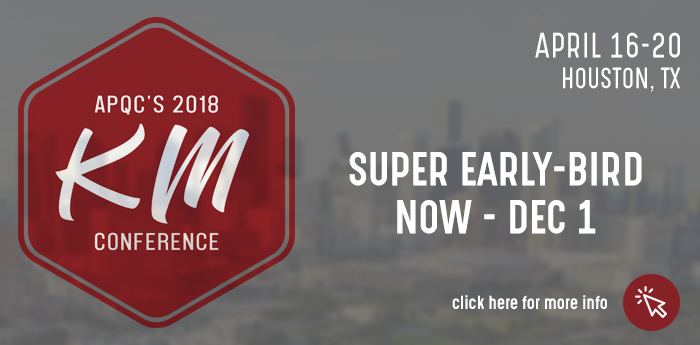November 15 is “Clean Your Refrigerator Day.” Have you ever cleaned out your fridge and discovered some expired old food you’d forgotten about, hidden way in back behind the milk? It can be hard to throw some things away, especially when they seemed like good ideas once upon a time. But when the expiration date has come and gone, you know they’re no good anymore, and it’s time to let them go.
 The same can be said of certain knowledge management practices that may have been useful once, but are now outdated and stale. Dispensing with these expired approaches gives you room to experiment with fresh ideas that may help you achieve your knowledge and collaboration goals.
The same can be said of certain knowledge management practices that may have been useful once, but are now outdated and stale. Dispensing with these expired approaches gives you room to experiment with fresh ideas that may help you achieve your knowledge and collaboration goals.
Here are three common practices that have run their course and need to be “cleaned out” of your KM kitchen.
1. A one-size-fits-all model for virtual communities
A decade ago, standardized communities of practice were all the rage. KM teams tended to have strict requirements for their communities, and anything not meeting that standard was considered outside the scope of the community program. But today, the one-size-fits-all approach just doesn't fit. APQC’s research shows organizations are embracing—and benefiting from—more flexible community structures that accommodate a wider variety of needs and objectives.
Best-practice community programs have become more inclusive, providing a home for everything from formal cross-functional collaboration to casual networking and online chat among peers. One of the biggest shifts in APQC's latest research is a rise in less-business-focused groups where employees can connect on topics of personal interest, from demographic affiliations to travel and hobbies. Technology makes it easy to form and customize groups, whether they are enduring communities stewarding discipline knowledge or short-term collaboration hubs designed to support event or initiative.
Best-practice organizations still differentiate between true communities of practice tackling targeted business goals and less formal collaboration groups—but the community program provides at least some level of support for all the variations. As an easy entry point into the community program, the less structured groups help employees find their niche and start contributing. Empowering each community to design its own site and roster of activities also increases engagement.
2. A focus on collecting information instead of connecting people
 It's great to find that content piece with the information you're looking for, but there's no substitute for the knowledge that resides in the heads of your employees. Some knowledge just can't be captured in documents or even videos; the best way to get to it is through one-on-one interaction.
It's great to find that content piece with the information you're looking for, but there's no substitute for the knowledge that resides in the heads of your employees. Some knowledge just can't be captured in documents or even videos; the best way to get to it is through one-on-one interaction.
Today's most effective KM programs connect people not just to information, but also to one another. When APQC completed its last major study on content management a few years ago, it found that best-practice organizations think about access to content, expertise, and community as three aspects of a cohesive whole. For example, most combine content search with the ability to quickly locate an expert who is knowledgeable about a specific topic or authored content on the topic. Easy access to people “in the know” improves the quantity and quality of solutions available to employees, helps bring novices and newcomers up to speed faster, and cuts down wasted time spent tracking down information. It also helps people get the context and advice they need to sort through information and put the best knowledge to work quickly.
Communities and networks also play an important role in finding and filling content gaps to ensure that relevant knowledge is documented wherever possible. Best-practice organizations use these groups for collaborative content generation, feedback, and informal peer review. Networks are also a source of content recommendations, which helps participants locate content that others have found valuable. And comments in communities and repositories are a great crowdsourced way to pinpoint content that needs to be improved or updated.
3. Expertise systems that rely on employees manually updating their own profiles
Some organizations get a lot of value from their internal expertise profiles, but many others have struggled to gain traction with profile systems. Either employees don’t fill the profiles out or, even if there is an initial push to complete them, they don’t keep them updated. When profiles are incomplete or contain old information, people don’t use them, making it even less likely people will update their information. This leads to a classic death spiral of low adoption and use.
And yet there is a huge need for better information on colleagues and internal experts. People want to know who they can contact to learn about specific topics and processes, how these people are connected to them, and whether they’re likely to be responsive to requests. In addition to frustrating employees, insufficient data about experts and coworkers appears to have a direct impact on business outcomes: 79 percent of respondents on a recent APQC survey said that they would be more productive if they had better tools to find and connect with colleagues based on their experience and expertise.
Some organizations avoid the pitfalls of manual expertise profiles by automatically piping in data from other systems, such as HR, professional development, and project tracking. This strategy has been around for years, but new technology makes these connections easier and less expensive. The result is a more complete database that requires much less user intervention to stay current and accurate.
Other organizations forgo profiles entirely and let employee-to-expert connections grow organically through internal social media platforms such as Yammer, Jive, or Slack. This strategy has significant drawbacks—and it doesn’t replace formal subject matter experts providing thought leadership through a community or discussion forum—but it does allow employees to get quick answers and build their own relationships with colleagues who can to fill in knowledge gaps.
And as “smart” technologies come into the digital workspace, opportunities are expanding to mine enterprise data for insight into what and who people know in order to make targeted expertise recommendations. Instead of relying on manual profiles, cognitive systems will extrapolate an employee’s expertise by continuously scanning and analyzing a range of sources, from HR and training records to items the person has searched for, read, authored, or commented on. These types of systems should also be able to tailor their expertise recommendations based on each user’s role, level, location, and preferences.
Out With the Old, In With the New
Next time you reach into your KM fridge, take inventory of what’s in there that may have grown stale, and think about fresh approaches that might better sustain your KM goals. (If you’re looking for inspiration in this context, we recommend attending APQC’s 2018 Knowledge Management Conference for an infusion of innovative ideas and techniques that are working for other organizations.) Tossing out the old ideas and bringing in new ones may be just the thing to get knowledge flowing more effectively across your organization.
Follow me on Twitter @LTrees_KM or find me on LinkedIn.